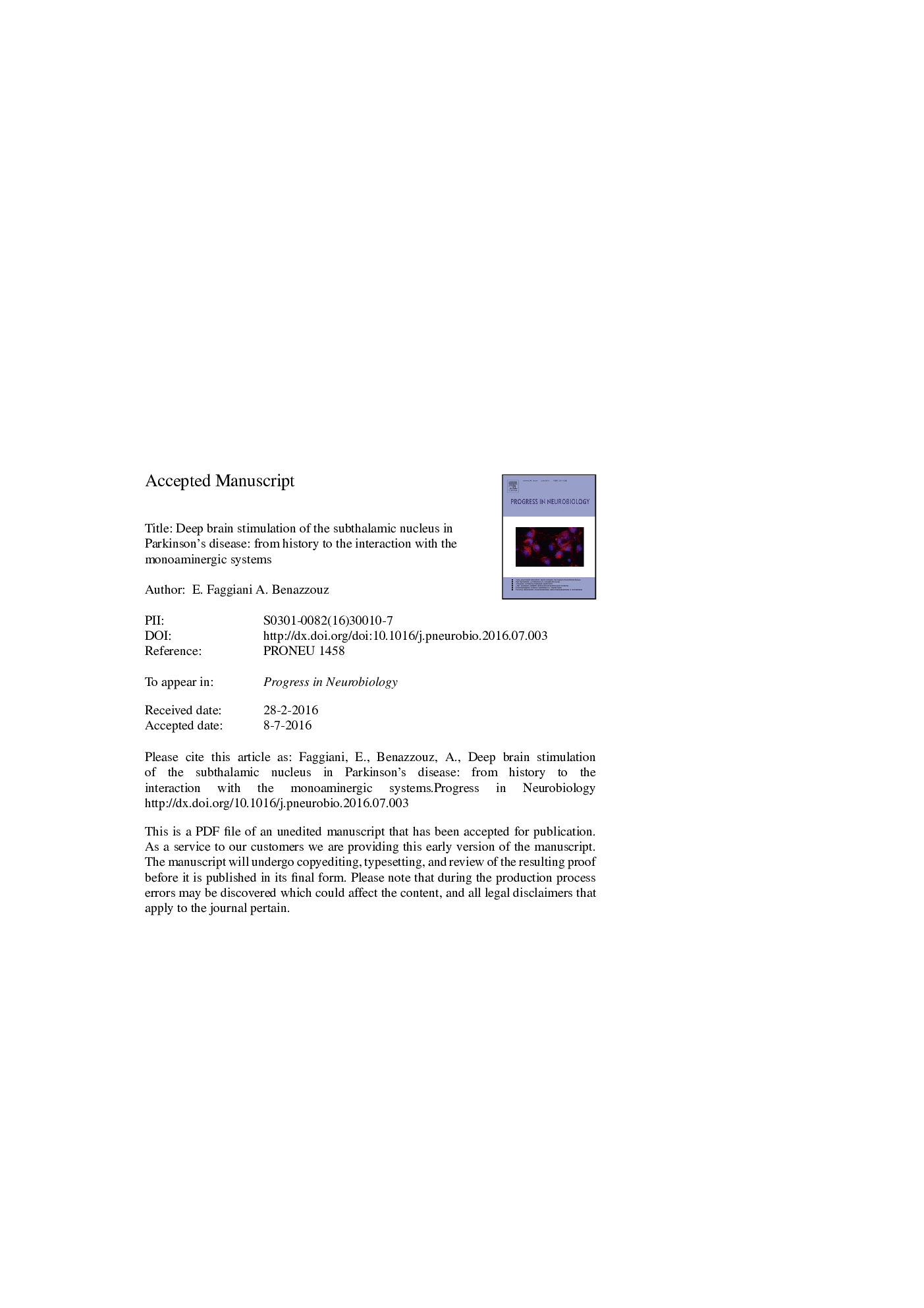| کد مقاله | کد نشریه | سال انتشار | مقاله انگلیسی | نسخه تمام متن |
|---|---|---|---|---|
| 5739091 | 1615364 | 2017 | 67 صفحه PDF | دانلود رایگان |
عنوان انگلیسی مقاله ISI
Deep brain stimulation of the subthalamic nucleus in Parkinson's disease: From history to the interaction with the monoaminergic systems
ترجمه فارسی عنوان
تحریک مغز عمیق هسته سوپتوالاموس در بیماری پارکینسون: از تاریخ تا تعامل با سیستم های مونوآمینرژیک
دانلود مقاله + سفارش ترجمه
دانلود مقاله ISI انگلیسی
رایگان برای ایرانیان
کلمات کلیدی
MPTPSubstantia nigra reticulatamethyl-4-phenyl-1,2,3,6-tetrahydropyridineVIMOCDGPiSTNDBSSNRGPESNC6-Hydroxydopamine5-HT6-OHDAl-DOPA - L-DOPAobsessive-compulsive disorder - اختلال وسواس فکری یا عملیParkinson disease - بیماری پارکینسونdeep brain stimulation - تحریک عمقی مغزPositron emission tomography - توموگرافی گسیل پوزیترونabnormal involuntary movement - حرکت غیرمعمول غیر طبیعیDopamine - دوپامینDorsal raphé - رفسنجی پشتیSerotonine - سروتونینlocus coeruleus - لوکوس سیرولئوسPPN - مالیات بر ارزش افزودهCSF - مایع مغزی نخاعیCerebrospinal fluid - مایع مغزی نخاعیSubstantia nigra compacta - متراکم توده سیاهnoradrenaline - نورآدرنالین norepinephrine - نوراپی نفرینAIM - هدفPedunculopontine nucleus - هسته PedunculopontineSubthalamic nucleus - هسته ی زیرهالامیکPET - پت
ترجمه چکیده
بیماری پارکینسون دومین شایعترین اختلال نورودنژنتیک است که به واسطه تظاهرات نشانه های حرکتی مشخص می شود که عمدتا مربوط به انحطاط نورون های دوپامین در قطعه ساز پارس موریتی نگری می باشد. بر اساس پیشرفت های درک پاتوفیزیولوژی بیماری، به ویژه در مدل های حیوانی، هسته سوپتوالاموس به عنوان یک هدف اصلی برای تحریک مغزی عمیق در درمان علائم حرکتی اشاره شده است، که ابتدا در پریمتیون غیر انسانی توسعه یافته و سپس با موفقیت انتقال داده شد به بیماران پارکینسونی. با این وجود، علیرغم تمرکز بر نقص های حرکتی، بیماری پارکینسون نیز با تظاهر علائم غیر حرکتی مشخص می شود که می تواند به علت انحطاط اضافی سیستم نوراپی نفرین، سروتونین و کولینرژیک باشد. پاتوفیزیولوژی علائم غیر مغزی مورد مطالعه قرار گرفته و در نتیجه به خوبی درمان نمی شود. علاوه بر این، داده های ادبیات پیرامون تاثیر تحریک مغزی عمیق متعلق به مغز بر اختلالات غیر موروثی بحث برانگیز و هنوز تحت بحث هستند. به طور مشابه، خطر اختلالات خلقی پس از جراحی مغز تحریک مغز همچنان بحث برانگیز است. در اینجا، ما اطلاعات بالینی و تجربی این روش جراحی مغز و اعصاب را در رفتارهای موتور و غیر مورچه بررسی می کنیم و شواهدی برای تعامل آن با سیستم های مونوآمینرژیک ارائه می دهیم.
موضوعات مرتبط
علوم زیستی و بیوفناوری
علم عصب شناسی
علوم اعصاب (عمومی)
چکیده انگلیسی
Parkinson's disease is the second most common neurodegenerative disorder, characterized by the manifestation of motor symptoms, which are mainly attributed to the degeneration of dopamine neurons in the pars compacta of substantia nigra. Based on advancements in the understanding of the pathophysiology of the disease, especially in animal models, the subthalamic nucleus has been pointed as a major target for deep brain stimulation in the treatment of motor symptoms, first developed in non-human primate and then successfully transfered to parkinsonian patients. Nevertheless, despite the focus on motor deficits, Parkinson's disease is also characterized by the manifestation of non-motor symptoms, which can be due to the additional degeneration of norepinephrine, serotonin and cholinergic systems. The pathophysiology of the non-motor symptoms is under studied and consequently not well treated. Furthermore, data from the literature about the impact of subthalamic deep brain stimulation on non-motor disorders are controversial and still under debate. Similarly, the risk of mood disorders post-deep brain stimulation surgery remains also controversial. Here, we review the clinical and experimental data of this neurosurgical approach on motor and non-motor behaviors and provide evidence for its interaction with the monoaminergic systems.
ناشر
Database: Elsevier - ScienceDirect (ساینس دایرکت)
Journal: Progress in Neurobiology - Volume 151, April 2017, Pages 139-156
Journal: Progress in Neurobiology - Volume 151, April 2017, Pages 139-156
نویسندگان
E. Faggiani, A. Benazzouz,
